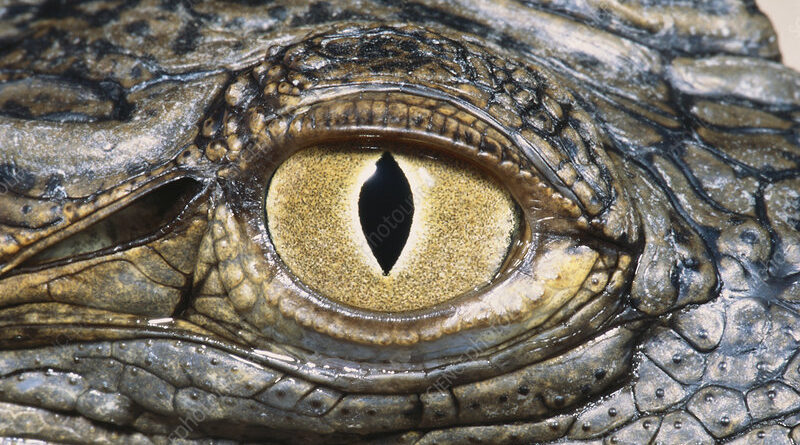Nile Crocodile Eyesight Adaptations
Nile Crocodile Eyesight Adaptations The Nile crocodile (Crocodylus niloticus) is one of the most formidable predators in the animal kingdom, renowned for its powerful jaws, stealthy movements, and remarkable adaptations. Found across sub-Saharan Africa, these reptiles have evolved to thrive in various habitats, from freshwater rivers and lakes to brackish coastal areas. Among their most crucial adaptations is their eyesight, which plays a vital role in hunting and survival. This article explores the fascinating adaptations of the Nile crocodile’s eyesight, revealing how these creatures have evolved to become effective hunters both in water and on land.
Anatomy of the Nile Crocodile’s Eye
A. Structure of the Eye
The Nile crocodile’s eye is a marvel of evolutionary design, specifically tailored to its environment. The anatomy of their eyes includes several key structures:

- Cornea: The cornea of a Nile crocodile is relatively flat, allowing for better underwater vision. This adaptation is essential for hunting aquatic prey, as it minimizes distortion when the crocodile’s eye is submerged.
- Lens: The lens of the crocodile’s eye is large and spherical, aiding in focusing light both in and out of water. This unique shape allows for better clarity and detail, which is crucial for spotting prey from a distance.
- Retina: The retina contains a high density of rod cells, which are sensitive to light and movement. This feature enhances the crocodile’s ability to see in low-light conditions, making them effective nocturnal hunters.
B. Comparison with Human Eyes
When compared to human eyes, several differences become apparent:
- Size and Shape Differences: Nile crocodile eyes are larger relative to their body size than human eyes, which aids in their ability to see better in dim light. Additionally, their eyes are positioned more laterally on their heads, providing a wider field of view.
- Positioning of the Eyes: While humans have forward-facing eyes that provide excellent depth perception, Nile crocodiles benefit from a more lateral positioning, giving them a broader perspective of their surroundings, which is crucial for detecting movement in the water.
Here’s a table summarizing the adaptations of the Nile crocodile’s eyesight:
| Aspect | Description | Significance |
|---|---|---|
| Eye Structure | Flat cornea, large spherical lens, and a high-density rod cell retina. | Enhances vision in low light and minimizes distortion underwater. |
| Dual Vision Capabilities | Effective vision both above and below water. | Allows detection of prey and threats in various environments. |
| Nictitating Membrane | Translucent third eyelid that protects the eye while swimming. | Safeguards against debris and injury without obstructing vision. |
| Color Vision | Limited color perception due to different types of photoreceptors. | Helps identify prey and navigate through their habitat. |
| Low-Light Adaptation | Presence of tapetum lucidum enhances night vision. | Facilitates hunting during dawn and dusk, when prey is more active. |
| Depth Perception | Binocular vision provides depth perception for tracking prey. | Improves ambush tactics and navigation through complex underwater environments. |
| Hunting Strategies | Utilizes ambush tactics and keen observation of visual cues. | Increases success in capturing prey and minimizes energy expenditure. |
| Communication | Visual displays and eye contact for social interactions. | Important for establishing dominance and readiness to mate among crocodiles. |
This table captures the key aspects of Nile crocodile eyesight adaptations, providing a concise overview of their significance in the animal’s survival and hunting strategies.
Adaptations for Aquatic and Terrestrial Environments
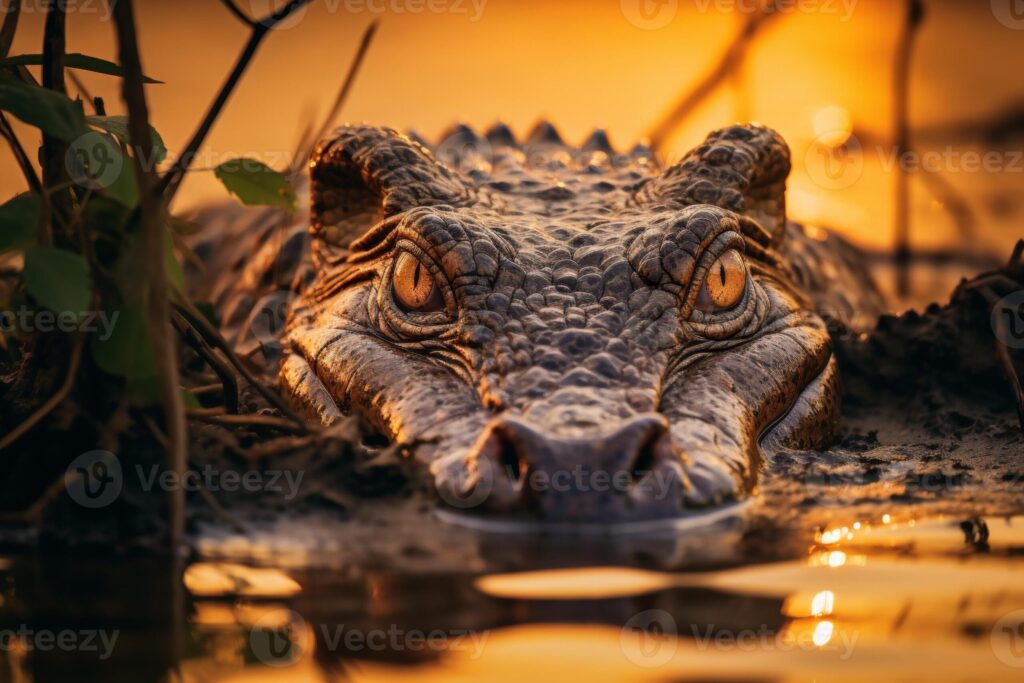
A. Dual Vision Capabilities
Nile crocodiles possess remarkable dual vision capabilities that allow them to see effectively both above and below water:
- Vision Above Water: When basking or resting at the water’s surface, crocodiles can spot potential threats or prey with clarity. Their eyes can adapt to varying light conditions, ensuring they remain vigilant.
- Vision Underwater: When submerged, the Nile crocodile can see with precision due to its flat cornea and specialized lens, enabling it to track prey while minimizing the distortion of light. This ability is crucial for ambushing fish and other aquatic animals.
B. Nictitating Membrane
Another significant adaptation is the presence of a nictitating membrane, a translucent third eyelid that serves multiple functions:
- Function and Benefits: The nictitating membrane protects the eye from debris and injury while swimming. It can cover the eye without obstructing vision, allowing the crocodile to keep watch while remaining submerged.
- Protection Against Debris and Injury: In murky waters, where visibility is low, this membrane is essential for safeguarding the delicate structures of the eye against potential damage from underwater plants, rocks, and prey.
Color Vision and Sensitivity
A. Color Perception in Nile Crocodiles
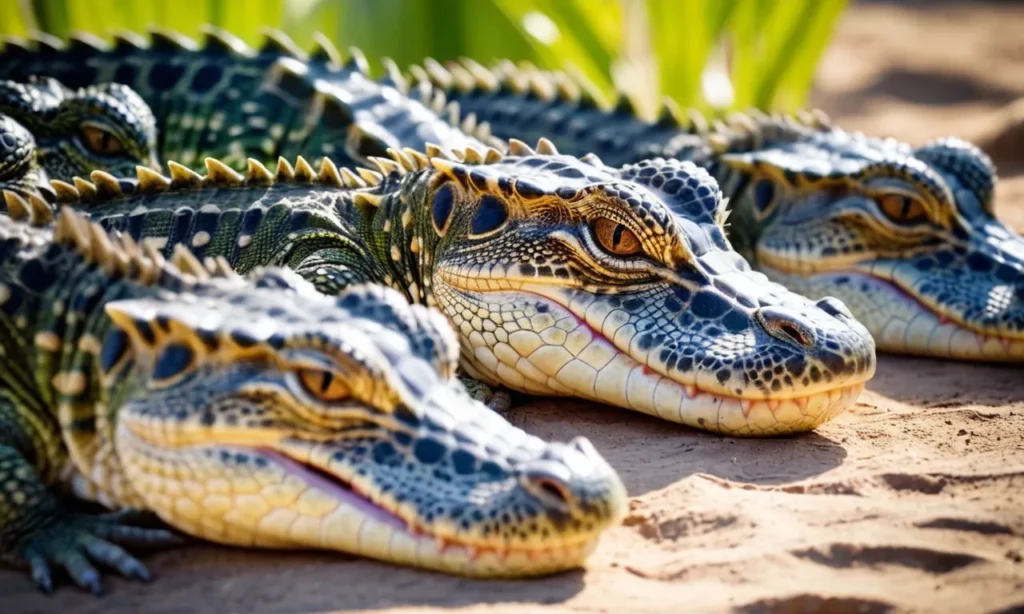
Research indicates that Nile crocodiles possess some degree of color vision, though it may not be as refined as that of humans:
- Types of Photoreceptors: Their retinas contain different types of photoreceptors, allowing them to perceive a limited spectrum of colors. This adaptation is beneficial for distinguishing between various prey and detecting changes in their environment.
- Implications for Hunting and Navigation: Understanding color differences can help crocodiles identify potential prey and navigate through their habitats, making them more efficient hunters.
B. Adaptation to Low-Light Conditions
Nile crocodiles are primarily crepuscular and nocturnal hunters, relying on their ability to see in low-light conditions:
- Tapetum Lucidum: This reflective layer behind the retina enhances their night vision by reflecting light that passes through the retina back into the eye, giving them a second chance to capture available light. This adaptation makes them particularly effective at hunting during dawn and dusk when their prey is most active.
- Benefits for Nocturnal Hunting: The combination of their large eyes, high rod cell density, and tapetum lucidum allows Nile crocodiles to hunt efficiently in low-light conditions, giving them an advantage over prey that may not be as adept at seeing in the dark.
Depth Perception and Tracking
A. Binocular Vision Advantages
While their eye positioning provides a wide field of view, Nile crocodiles have also developed effective binocular vision that enhances depth perception:
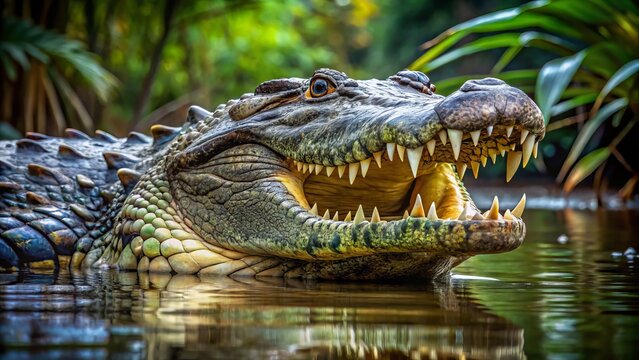
- Tracking Prey: This capability is crucial for tracking fast-moving prey, such as fish or birds. The ability to gauge distances accurately allows them to time their ambushes more effectively.
- Navigating Through Water: Depth perception also aids in navigating through complex underwater environments, helping them avoid obstacles while pursuing prey.
Behavioral Adaptations Related to Eyesight
A. Hunting Strategies
The eyesight adaptations of Nile crocodiles directly influence their hunting strategies:
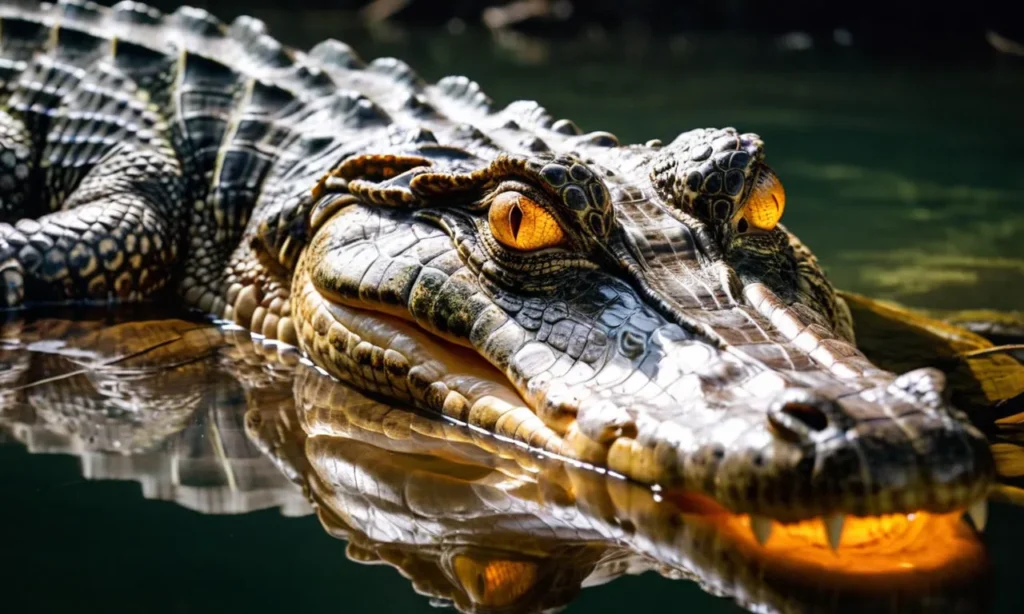
- Ambush Tactics: Crocodiles often employ ambush tactics, using their ability to remain nearly invisible in the water while maintaining keen vision. They can detect movements above the surface, allowing them to strike with precision.
- Visual Cues Used During Hunting: Nile crocodiles are adept at interpreting visual cues from their environment, such as the ripples created by struggling prey. This keen observation helps them plan and execute successful hunts.
B. Communication Through Eye Signals
Eyesight also plays a role in social interactions among Nile crocodiles:
- Interactions with Other Crocodiles: They communicate with each other through visual displays, including eye contact and body posture, signaling aggression, submission, or readiness to mate.
- Use of Visual Displays During Mating: During the mating season, crocodiles may engage in displays that highlight their physical prowess and readiness to mate. Their eyesight is essential for recognizing and responding to these visual cues.
Conclusion
The adaptations of the Nile crocodile’s eyesight are a testament to the remarkable ways in which nature equips creatures for survival. From their specialized eye anatomy and dual vision capabilities to their keen sensitivity to light and color, these adaptations enable Nile crocodiles to thrive in their aquatic and terrestrial environments. Understanding these adaptations not only sheds light on the biology of these fascinating reptiles but also emphasizes their role as apex predators in their ecosystems. The Nile crocodile’s eyesight is more than just a tool for hunting; it is a key component of their survival strategy, illustrating the intricate connections between form, function, and environment in the animal kingdom.
Tips for Understanding Nile Crocodile Eyesight Adaptations
Observe in Their Natural Habitat:
- If possible, visit a wildlife reserve or national park where Nile crocodiles are found. Observing their behavior in the wild can give you insights into how they use their eyesight for hunting and navigating their environment.
Study Their Behavior:
- Pay attention to how crocodiles position themselves near the water’s edge. Notice their stillness and how they react to movements above and below the surface. This can highlight their ambush strategies and visual acuity.
Learn About Their Anatomy:
- Familiarize yourself with the specific structures of their eyes, such as the cornea, lens, retina, and nictitating membrane. Understanding these features can deepen your appreciation of their adaptations.
Research Their Color Vision:
- Look into studies that explore the color perception of crocodiles. Knowing how they perceive colors can provide context for their hunting strategies and interactions with other animals.
Understand Environmental Impact:
- Recognize how factors like water clarity and lighting conditions can influence a crocodile’s ability to see. This knowledge can enhance your understanding of their habitat preferences and behavior.
Watch Documentaries and Educational Programs:
- Seek out documentaries focused on Nile crocodiles or reptiles in general. These often provide visual demonstrations of their adaptations in action.
Respect Their Space:
- When observing crocodiles in the wild, maintain a safe distance. Respect their territory, as they are wild animals with powerful instincts.
Discuss with Experts:
- Engage with wildlife biologists or guides who specialize in reptiles. Their expertise can provide you with detailed insights and answers to your questions about crocodile adaptations.
Consider Conservation Efforts:
- Learn about the conservation status of Nile crocodiles and the threats they face. Understanding the ecological role of these predators can foster a greater appreciation for their adaptations.
Keep a Journal:
- If you’re studying Nile crocodiles, keep a journal of your observations and findings. Documenting your experiences can help solidify your knowledge and understanding of their adaptations.
FAQ: Nile Crocodile Eyesight Adaptations
What adaptations do Nile crocodiles have for seeing underwater?
Nile crocodiles have a flat cornea and a spherical lens, which minimize distortion when they are submerged. Their eyes are also equipped with a nictitating membrane that protects the eye while maintaining visibility underwater.
Can Nile crocodiles see in color?
Yes, Nile crocodiles have some degree of color vision due to the presence of different types of photoreceptors in their retinas. However, their color perception is limited compared to humans.
How do Nile crocodiles see at night?
Nile crocodiles are primarily crepuscular and nocturnal hunters. They possess a layer called the tapetum lucidum behind their retina, which reflects light and enhances their night vision, allowing them to hunt effectively in low-light conditions.
How does the positioning of their eyes benefit Nile crocodiles?
The eyes of Nile crocodiles are positioned more laterally on their heads, providing a wider field of view. This positioning allows them to detect movement in the water and spot potential prey or threats from various angles.
What role does the nictitating membrane play?
The nictitating membrane is a translucent third eyelid that protects the crocodile’s eyes while swimming. It can cover the eye without obstructing vision, shielding it from debris and injury.
How do crocodiles use their eyesight while hunting?
Nile crocodiles rely on their keen eyesight to detect movements both above and below the water’s surface. They employ ambush tactics, often remaining still to blend into their surroundings until they can strike at the right moment.
Do Nile crocodiles have good depth perception?
Yes, Nile crocodiles have developed binocular vision that enhances their depth perception. This ability is crucial for accurately judging distances when tracking prey or navigating through complex underwater environments.
How does the crocodile’s eyesight compare to that of other reptiles?
Nile crocodiles have evolved unique adaptations that give them excellent vision in both aquatic and terrestrial environments. While many reptiles have good eyesight, crocodiles’ specific adaptations, such as their nictitating membrane and tapetum lucidum, set them apart as highly effective hunters.
What environmental factors affect crocodile vision?
Water clarity, lighting conditions, and habitat structure can all influence a crocodile’s ability to see. For instance, murky waters can limit visibility, while bright sunlight can create glare that impacts their vision.
How can I safely observe Nile crocodiles in the wild?
If you’re interested in observing Nile crocodiles, visit a wildlife reserve or national park with guided tours. Always maintain a safe distance, respect their territory, and follow the guidance of experienced wildlife professionals.
